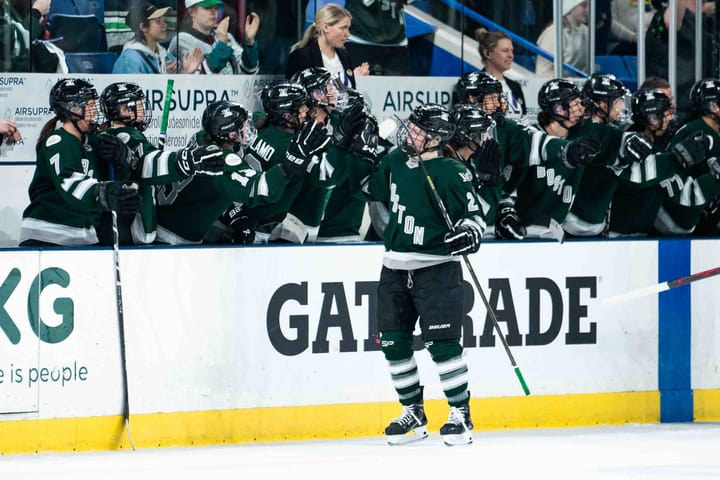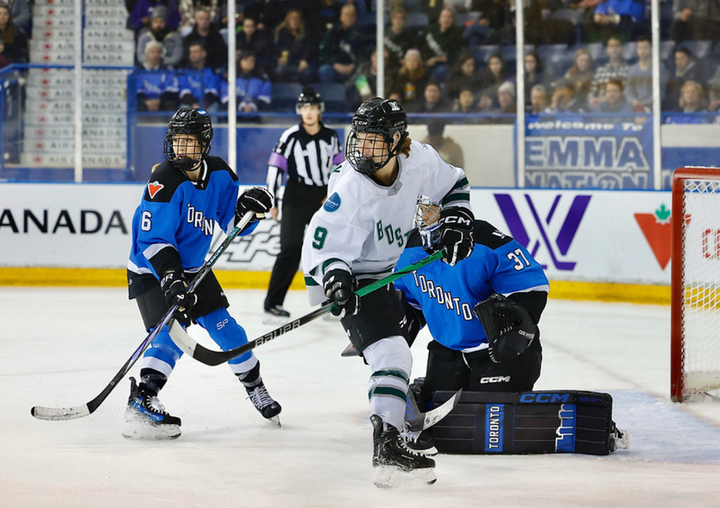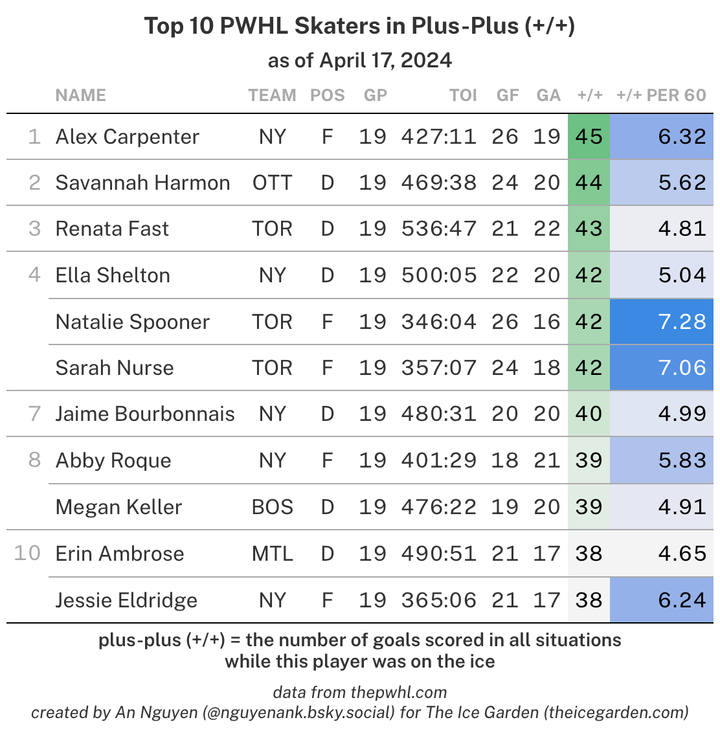Elite athlete funding in the U.S. and Canada: How national team players get paid
Hockey Canada and USA Hockey support their athletes' training in different ways, but neither model is what the U.S. Women's National Team is looking for.
On Wednesday morning, members of Team USA published a statement asserting that they will not be playing in the 2017 Women's World Championship unless considerable gains are made in their ongoing negotiations with USA Hockey. In particular, their assertion that USA Hockey pays members of the Women's National Team just $1,000 per month for a six-month period every four years, totalling $6,000, sparked outrage. USA Hockey, meanwhile, responded with claims that it would be providing the potential for players to earn as much as $85,000 in the Olympic year. But what do these figures represent, and how does athlete funding operate in women's hockey, anyways?
Team USA funding, as it stands
The United States does not provide federal funding to athletes. Rather, financial support for elite athletes is provided primarily by the United States Olympic Committee (USOC), with various corporations also offering general athlete funding through both grants and job programs.
The USOC, which oversees Olympic sport in the U.S., directs funding to various national governing bodies in order to support athlete development. Resources are allocated based on the potential for success at the international level. For the 2011-2014 quadrennium, ice hockey was one of the USOC's prime beneficiaries, with USA Hockey receiving $6.8 million to be put towards training programs and the Direct Athlete Support scheme. According to the USOC's tax filings for 2015, USA Hockey received a cash grant of $1,609,860 in that year for the purpose of "furthering Olympic and Paralympic support". USA Hockey similarly received $1,968,273 from the USOC in 2013 and $1,854,943 in 2014. These numbers are among the highest grant amounts distributed to any national governing body in the United States.
A portion of the money granted to USA Hockey by the USOC is distributed directly to athletes in the form of monthly stipends. This funding scheme primarily affects post-collegiate women's hockey players. The criteria for receiving Direct Athlete Support in team sports are determined by their respective governing bodies, but stipend amounts typically range from $400 to $2000 per month. In a New York Times article, members of the USA Hockey women's program confirmed that they receive between $750 and $2000 monthly, or $9,000 to $24,000 annually. Presuming they meet the criteria defined by USA Hockey, athletes are eligible to receive this USOC funding in all years, not only when centralized.
USA Hockey supports the equitable treatment of our female athletes, a commitment going back decades: https://t.co/fTfFM8g24A pic.twitter.com/s6w4kLDFiu
— USA Hockey (@usahockey) March 15, 2017
When members of the U.S. Women's National Hockey Team state that they receive just $6,000 in direct funding from USA Hockey every four years, this is not untrue. However, players in the program do consistently receive the USOC funding that USA Hockey, as a governing body, is mandated to distribute. While the athletes are emphasizing the meagre amount paid directly by USA Hockey, USA Hockey, in turn, has mobilized the total figures that it distributes (or may hypothetically distribute), including USOC funds.
In a statement released Wednesday afternoon, USA Hockey claims that "the support [it] is implementing in order to prepare the Women’s National Team for the 2018 Winter Olympic Games includes ... additional support stipends and incentives for medals that could result in each player receiving nearly $85,000 in cash over the Olympic training and performance period.” However, the U.S. Women's National Hockey Team published a response to this statement attesting that USOC funding figures are being included by USA Hockey in calculating the potential $85,000 total.
In December 2016, the United States Olympic Committee announced that it would be increasing its monetary rewards for athletes who medal at the Olympic Games — known as Operation Gold — by 50 percent in each category, bringing the amounts to $37,500 for gold, $22,500 for silver, and $15,000 for bronze. The USOC also offers bonus money for strong performances at the World Championships in non-Olympic years, which max out at $7,500.
#BeBoldForChange pic.twitter.com/dg1Qiix9mp
— Monique Lamoureux-M (@moniquelam7) March 15, 2017
Combining the $24,000 that a Team USA athlete is eligible to receive annually in USOC stipends with the potential of $37,500 in Operation Gold reward money yields a total of $61,500. In an addendum to the players' response, Monique Lamoureux-Morando explained that USA Hockey has proposed a scheme in which it would pay the athletes "about 20k," while the rest of the "nearly $85,000 in cash” that USA Hockey cites refers to USOC funding in the form of Direct Athlete Support and Operation Gold bonus money that is merely distributed by USA Hockey. Moreover, it is not made clear whether the roughly $20,000 that USA Hockey itself would pay involves results-based performance incentives that are not guaranteed.
How does this compare to Hockey Canada's system?
Unlike in the United States, athletes in Canada receive tax-exempt federal funding. Though the source differs, the funding ultimately measures up similarly, with Sport Canada money playing a roughly analogous role to USOC stipends. The Sport Canada Athlete Assistance Program operates on a carding system, wherein elite athletes are carded ― or deemed eligible to receive federal funding ― according to criteria determined by their governing body in accordance with broader regulations. Carding occurs at various levels, including several senior categories and a developmental category. The carding status that an athlete is nominated to determines the amount of funding they are eligible to receive as well as the duration (one or two years) for which they maintain that particular eligibility.
The system appears at first glance to be rather complex, but ultimately athletes on established senior international or national cards (SR1, SR2, and SR) are generally eligible to receive up to $18,000 annually in living allowance while athletes on first-year senior national (C1) or development (D) cards are eligible to receive up to $10,800 a year in living allowance. Funds such as tuition support and performance bonuses may also be granted. The carding status accorded to each athlete is determined by their governing body, while the precise monetary amount each athlete receives is calculated by Sport Canada.
At Hockey Canada, the Women's High Performance Advisory Committee (WHPAC) ― composed of five high-performance athletes ― has input on the way that players are evaluated for carding status. The allowance received through Sport Canada comprises the majority of funding that members of Team Canada receive, and the criteria Hockey Canada uses to determine its carding nominations are governed by contracts that are negotiated by the WHPAC on an annual basis. Hockey Canada-specific funding contracts also come into play for pre-Olympic centralization over periods totalling approximately 11 months, beginning after the World Championship that precedes the Olympic year and ending about a month after the Olympic Games.
"On the Olympic basis, in our world we look to support our players for a minimum of nine months, full-time," said Melody Davidson, Hockey Canada's general manager of national women's programs. "That's the 23 that will go to the Olympic Winter Games, and that would be from July 1 (2017) until March 31, 2018. We also look to negotiate support leading out of this year's World Championship through into July 1, 2017."
Though not a players' union, the WHPAC is involved in negotiating the terms of these contracts with Hockey Canada, and also serves as a formal channel through which athletes can voice any concerns they may have. The committee is currently chaired by recently-retired forward Caroline Ouellette, with Brianne Jenner and Lauriane Rougeau serving as representatives from the senior team, Halli Krzyzaniak representing the development team, and Emma Maltais as the U18 representative.
"We have all the communication about players' concerns about the program, improving player well-being― that all goes through our committee," Jenner explained. "We also engage with Hockey Canada in terms of our contract negotiations both for our non-Olympic years and our Olympic years. So we are essentially like an NHLPA for our program. We're currently in our Olympic contract talks now in these past couple weeks and things are progressing positively. We definitely have a proper channel for improving player well-being and it seems to be working quite well for us."
Although players and staff declined to reveal the monetary details of centralization contracts, The Canadian Press has reported that Hockey Canada paid players about $2,500 per month during centralization prior to the Sochi Games. Additionally, Davidson stated that in non-Olympic years, Hockey Canada supplements the Sport Canada funding of any player on a development card who is selected to the World Championship roster so that they are on an equal basis with their senior-carded teammates.
Hockey Canada players appear to have a much stronger working relationship with their governing body than their American counterparts, but the funding structure that exists in Canada is neither what the U.S. players are demanding, nor entirely sufficient. In addition to federal Sport Canada funding, most Canadian provinces and territories have smaller-scale high-performance funding programs that generally provide amounts in the four-figure range. The Canadian Olympic Committee (COC) supplements this with $5,000 for eligible athletes in non-Olympic years and monetary rewards for Olympic medals, including $20,000 for gold. Yet despite government and COC support, Canadian athletes ― including women's hockey players ― rely heavily on external funding sources. Twenty-one of the 27 Team Canada members centralized prior to the 2014 Olympics received grants through CANFund, a non-governmental funding program that provides athletes up to $12,000 annually while taking into account financial need.
So is this all about a few thousand dollars?
The players have emphasized the small amount paid to them by USA Hockey, as well as areas in need of "equitable support" such as youth team development and equipment provision. The "chasm" described by attorney John Langel to the Associated Press, however, appears to lie with the U.S. team's demand for a four-year contract system wherein they would be paid by USA Hockey year-round, including in seasons when they are not centralized. Such a change would involve a major shift in the relationship between the athletes and USA Hockey.
In the governing body's statement regarding the team's protest, president Jim Smith insisted that "USA Hockey's role is not to employ athletes and we will not do so." While many have compared the U.S. women's hockey centralization program to its Canadian counterpart, the precedent for the players' most substantial demand does not lie with Hockey Canada. Rather, it appears that they seek to replicate the contractual structure of the U.S. women's national soccer team, whose players are employed and compensated by their federation on a full-time basis.
According to its 2015 tax return, which covers the fiscal year beginning Sept. 1, 2014 and ending August 31, 2015, USA Hockey had a net revenue of $663,259 and net assets valued at $3,927,405, with over 60 percent of its total revenue coming from membership fees. At first glance it may appear that given the organisation's finances, the team's demands are likely unreasonable. Unlike the United States Soccer Federation (USSF), which hosts an extensive schedule of exhibition matches that generate considerable revenue and benefits from substantial FIFA bonus awards (about 40 percent of the USSF's total revenue comes from international games), USA Hockey relies on a smaller income to finance its operations.
However, reports signal that $3.5 million is annually invested in the boy's development program while no strides are made towards providing similar infrastructure for girls hockey. If this is indeed accurate, USA Hockey's organisational and budgeted priorities deserve to be called into question. In the 2015 fiscal year, the body's eight directors combined to receive $2,106,561 in total compensation, and 15 other individuals are listed as having received over $100,000 of reportable compensation each, excluding bonuses.
USA Hockey has money: it is simply a question of where those funds are being allocated. This suggests that a serious investment in the development of women's and girls hockey would require not only a changed relationship between the Women's National Team and the organisation, but a fundamental restructuring of the way USA Hockey operates.





Comments ()